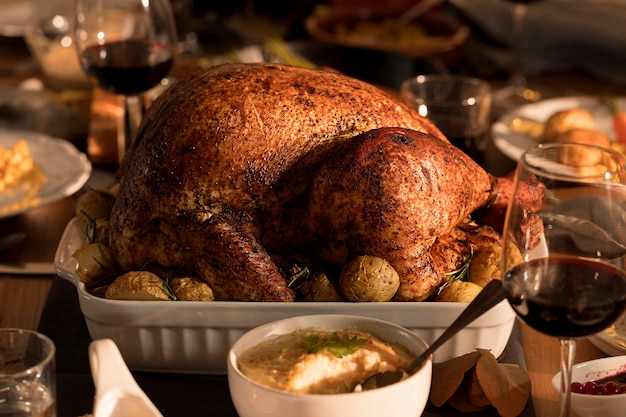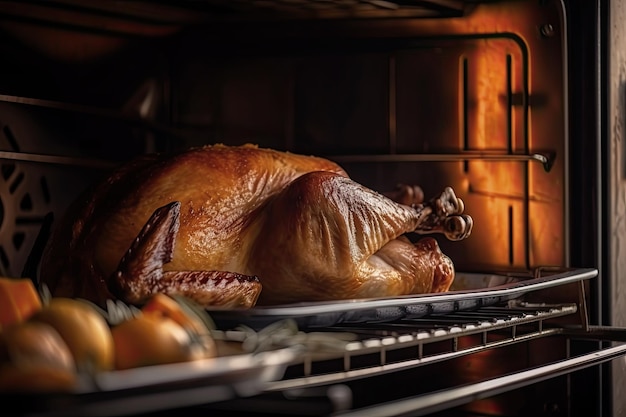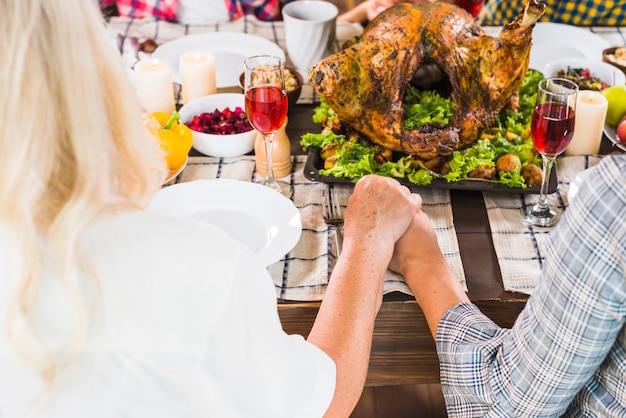Ah, the turkey. It’s the star of the festive table, the centerpiece of countless gatherings, and the source of endless debate over stuffing, gravy, and whether to brine or not. But let's face it, roasting a turkey can be a bit of a daunting task. There's so much to think about - the size, the stuffing, the timings, the gravy... It can feel like a whole lot of pressure to get it right! But fear not, dear reader! This is your ultimate guide to achieving a perfect roast turkey, from choosing the right bird to carving it like a pro.
We’re going to dive deep into every aspect of the turkey roasting process, from the basics to some handy tips and tricks I’ve picked up over the years. So, grab a cuppa, settle in, and let’s get started!
(Part 1) Choosing Your Turkey

The first step in any turkey roasting journey is choosing the right bird. Here’s a breakdown of the key considerations:
The Size Game
The first thing to think about is size. You want a turkey big enough to feed everyone comfortably without being so massive it takes forever to cook. As a general rule of thumb, you'll need about 1lb of turkey per person. So, if you're feeding 6 people, you'll need a turkey that's around 6lbs. But if you're a big family with a few extra hungry guests, you might want to go for a larger bird.
Fresh or Frozen?
Now, the age-old debate: fresh or frozen? I'm a firm believer in fresh turkeys – the flavour just seems richer and more intense. But, if you’ve got limited fridge space or are short on time, a frozen turkey is perfectly acceptable. Just make sure to thaw it out properly before cooking. You don’t want to end up with a half-frozen bird! Allow a day per 5lb of turkey to defrost it in the fridge.
The Weighty Issue
And finally, don't just go by the size on the label – always weigh your turkey yourself! This way, you can be sure you’re cooking it for the right amount of time. It’s a simple step that makes a big difference in getting that perfect roast.
(Part 2) Prepping Your Turkey

Now that you’ve got your turkey, it's time to get prepping.
The Brine Bath: A Tale of Two Methods
Brining is a simple but effective way to add moisture and flavour to your turkey. It’s a bit like a spa treatment for your bird! It involves soaking it in a salt water solution for a few hours. If you're short on time, a dry brine (rubbing salt all over the turkey and letting it sit in the fridge overnight) will also give you a great result.
The Great Turkey Rinse
Once your turkey is brined (or not!), it’s time to give it a good wash. Rinse it under cold water, then pat it dry with kitchen paper. Now, remove the giblets (those little bits of innards) and neck from inside the turkey cavity. You can use them to make a delicious stock, but we'll get to that later.
Stuffing: To Stuff or Not to Stuff
Stuffing is a personal choice, some people love it, others don't. If you're going for it, there are a few things to keep in mind. Firstly, don't overstuff your turkey! A tightly packed stuffing will take longer to cook and could potentially cause the turkey to be undercooked. Secondly, if you're using a stuffing that's got breadcrumbs in it, make sure to moisten it well. This will help to prevent it from drying out during cooking.
The Secret Ingredient: Butter
Now, we're getting to the good stuff - flavor! The best way to get a beautiful, crispy skin on your turkey is to rub it all over with softened butter. You can even add some herbs and spices for extra flavor. My personal favourite is a mix of rosemary, sage, and thyme, but you can use whatever you like.
(Part 3) Roasting Your Turkey

Finally, it’s time to roast!
Preheating is Key
Preheat your oven to 350°F (175°C). It’s important to get the oven up to temperature before you pop the turkey in.
Positioning is Everything
Now, it’s time to place your turkey in a roasting pan. Make sure it’s big enough to hold the bird without it being too crowded. You can either roast your turkey breast side up or breast side down. I prefer to roast it breast side up, as it helps to keep the breast meat moist. But if you’re looking for extra crispy skin, then roasting it breast side down is a good option.
The cooking time Debate
Now, we come to the big question – how long to cook the turkey? The general rule of thumb is to cook it for 15 minutes per pound for an unstuffed turkey, and 20 minutes per pound for a stuffed turkey. But the best way to determine if your turkey is cooked through is to use a meat thermometer. Insert the thermometer into the thickest part of the thigh, avoiding the bone. The turkey is cooked when the internal temperature reaches 165°F (74°C).
Basting: The Key to Moisture
During cooking, remember to baste your turkey every 30 minutes. Basting is simply pouring the juices from the pan over the turkey. This will help to keep the skin moist and prevent it from drying out.
(Part 4) Resting and Carving
Once the turkey is cooked, don't rush to carve it! Let it rest for at least 30 minutes. This will allow the juices to redistribute throughout the meat, resulting in a more tender and juicy turkey.
Carving Like a Pro
Now, let's talk about carving. There's no need to be intimidated, it's actually quite easy. Start by removing the legs and thighs. Cut through the joint where the leg meets the thigh, then use a carving knife to cut the skin along the top of the thigh. Gently pull the leg and thigh away from the carcass. Then, use the carving knife to slice the leg and thigh into serving-sized pieces. Next, remove the breast. Start by cutting through the skin along the breastbone. Then, use the carving knife to cut the breast away from the carcass, being careful not to tear the meat. Once you have the breast removed, you can slice it into thin pieces.
(Part 5) Gravy Time
No roast turkey is complete without a generous helping of gravy. And luckily, making gravy is easier than you might think. You can make your gravy directly from the pan juices, or you can use a stock.
Pan Juices Method:
Once you’ve removed your turkey from the roasting pan, pour off the excess fat. Then, add a cup of water to the pan and scrape the bottom with a wooden spoon to loosen any bits of stuck-on turkey. Bring the mixture to a boil and then simmer for a few minutes. Strain the gravy through a fine-mesh sieve into a jug.
Stock Method:
If you’re using stock, simply add a cup or two of stock to the pan and bring it to a simmer. Add some cornflour or flour to thicken the gravy.
The Finishing Touch:
No matter which method you use, season the gravy to taste. You can also add some herbs or spices, like a pinch of ground pepper or a bay leaf.
(Part 6) Leftovers: Don't Waste a Bite
turkey leftovers are a delicious way to stretch your meal. Here are a few ideas for using up your leftovers:
turkey sandwiches: Make some classic turkey sandwiches with mayonnaise, lettuce, and tomato.
turkey salad: Make a delicious turkey salad with chopped celery, onion, mayonnaise, and cranberries.
turkey soup: Use your turkey bones to make a flavourful and comforting turkey soup.
Turkey pies: Create individual turkey pies with puff pastry or a flaky crust.
Turkey hash: Combine leftover turkey with potatoes, onions, and your favorite seasonings for a hearty and satisfying meal.
Turkey enchiladas: Use leftover turkey to create flavorful and filling enchiladas.
(Part 7) Tips and Tricks
Here are a few handy tips to help you achieve turkey roasting perfection:
- Use a meat thermometer! This is the best way to ensure your turkey is cooked through and safe to eat.
- Don't overstuff the turkey! Overstuffing will make it harder to cook the turkey evenly.
- Baste your turkey regularly! Basting will help to keep the skin moist and prevent it from drying out.
- Let the turkey rest! Allowing your turkey to rest before carving will help to keep it juicy and tender.
- Don't be afraid to experiment with stuffing! Use your favourite bread, herbs, and spices to create a delicious and unique stuffing.
- Make sure your gravy is seasoned properly! A good gravy can really elevate your roast turkey.
- Consider using a roasting rack. This will allow air to circulate around the turkey, resulting in a more evenly cooked bird.
- Don't overcrowd the oven. If you're roasting other dishes alongside your turkey, make sure you have enough space to ensure everything cooks evenly.
Tried and True Recipe:
Here’s a simple and delicious recipe for roast turkey that I’ve been using for years:
Ingredients:
1 turkey (approximately 12-14 pounds)
1 tablespoon olive oil
1 teaspoon salt
1/2 teaspoon black pepper
1/4 teaspoon dried rosemary
1/4 teaspoon dried thyme
1/4 cup butter, softened
1 cup chicken broth
Instructions:
1. Preheat oven to 350 degrees F (175 degrees C).
2. Remove turkey giblets and neck from cavity. Rinse turkey inside and out with cold water and pat dry with paper towels.
3. In a small bowl, combine olive oil, salt, pepper, rosemary, and thyme. Rub mixture all over turkey, both inside and out.
4. Place turkey in a large roasting pan.
5. In a separate bowl, combine softened butter with chicken broth. Pour mixture over turkey.
6. Roast turkey for approximately 3 hours, or until the internal temperature reaches 165 degrees F (74 degrees C).
7. Let turkey rest for 30 minutes before carving.
(Part 8) Frequently Asked Questions
1. How do I know if my turkey is cooked through?
The best way to know if your turkey is cooked through is to use a meat thermometer. Insert the thermometer into the thickest part of the thigh, avoiding the bone. The turkey is cooked when the internal temperature reaches 165°F (74°C).
2. Can I stuff my turkey the night before?
It’s not recommended to stuff your turkey the night before. Stuffing that’s left out at room temperature can be a breeding ground for bacteria. The best way to stuff your turkey is to do it right before you put it in the oven.
3. What should I do with the turkey giblets and neck?
The turkey giblets and neck can be used to make a delicious stock. Simply add them to a pot with some water, vegetables, and herbs and simmer for a few hours. Strain the stock and use it for soups, stews, or sauces.
4. How do I store leftover turkey?
Store leftover turkey in the refrigerator in an airtight container for up to 4 days. You can also freeze leftover turkey for up to 3 months.
5. How can I prevent my turkey from drying out?
The best way to prevent your turkey from drying out is to baste it regularly during cooking. Basting will help to keep the skin moist and prevent it from drying out. You can also try brining your turkey before cooking. Brining will help to inject moisture into the meat.
(Part 9) A Final Word
And there you have it, your ultimate guide to roasting a perfect turkey! It's not as intimidating as it might seem, and with a little planning and practice, you’ll be a turkey roasting pro in no time. Remember, the key is to be patient and enjoy the process. After all, a roast turkey is a celebration of food, family, and good times. So, gather your loved ones, crack open a bottle of something festive, and get ready to enjoy the deliciousness of a perfectly roasted turkey. Happy holidays!
Everyone is watching

How to Cook Frozen Lobster Tails Perfectly: A Step-by-Step Guide
RecipesLobster. Just the word conjures up images of lavish meals, special occasions, and a taste of luxury. But let's...

Pigs in a Blanket Cooking Time: How Long to Bake for Perfect Results
RecipesAh, pigs in a blanket. Just the name conjures up images of those delightful little parcels of crispy pastry en...

Pork Fillet Cooking Time: How Long to Cook It Perfectly
RecipesPork fillet, or tenderloin as it's sometimes called, is a real favourite in our house. It's so versatile, and...

The Ultimate Guide to Tender, Juicy Pulled Pork
RecipesRight, let's talk pulled pork. It's one of those dishes that just screams "comfort food," doesn't it? I mean...

The Ultimate Guide to Cooking Sweet Potatoes: From Roasting to Mashing
RecipesSweet potatoes. Just the name conjures up images of warm, comforting dishes, bursts of vibrant color, and a to...
